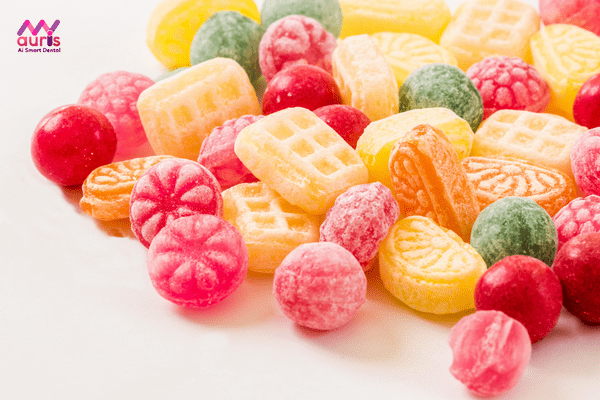Tooth decay is no longer strange, especially for young children. Because of the habit of eating a lot of sweets and not knowing how or being lazy about oral hygiene. Tooth decay not only destroys oral aesthetics but also affects the child’s ability to grow permanent teeth later. Therefore, parents are extremely worried because if a 3-year-old child has cavities in his front teeth, his teeth will be weak and vulnerable. To get the right way to handle and fix it, don’t miss this article.
Signs to recognize that a 3-year-old child has tooth decay
Children with tooth decay are The condition is common for many different reasons. In the early stages, the worm problem has just begun, so there are almost no signs and parents do not detect it. Parents detect when tooth decay develops through a number of signs in their child: complaining of tooth pain, skipping meals, loss of appetite, etc.
In addition, the front teeth are the front teeth, so the signs that appear will be more visible than the molars on the inside. Children with front tooth decay have some typical signs:
- On the teeth, black spots and holes appear between the teeth, tooth roots as well as the back of the teeth.
- Incisors become loose and chip into many small pieces if the decay is severe
- Sensation and discomfort when eating hot or cold foods
- Bad breath appears
- Reduced biting and tearing function in front teeth.

If signs of tooth decay are detected, parents should take the child to the dentist for check-up and examination. From there, the doctor will have the most appropriate treatment. Tooth decay should not be left for a long time because it will affect the ability to grow teeth later, causing dental diseases such as pulpitis, tooth loss, etc.
Causes of 3-year-old baby having front tooth decay
As you know, tooth decay in children has many causes, mainly due to the habit of eating a lot of sugar-rich foods. Besides, there are some main causes of tooth decay in 3-year-old children:
Teeth properties
3-year-old children with milk incisors are more susceptible to tooth decay than adults. Because baby teeth are the teeth that hold the position for future permanent teeth. And the enamel of baby teeth is thinner than that of permanent teeth, so it is easy for bacteria to attack and grow, causing tooth decay.
Children’s eating habits
Sugar-rich foods are always the favorite taste of most children. Children often love: cakes, candy, chocolate, carbonated soft drinks, bottled fruit juice, etc. However, sugar and coloring in foods coat teeth, damage tooth enamel, and increase the likelihood of tooth decay. If parents do not control the amount of sugar and starch that children consume, it will not only increase the risk of tooth decay and infection but also increase the risk of overweight and obesity.

Improper oral care
Children hardly know the importance of oral hygiene and if not guided and teachers are often lazy about oral hygiene. Parents think that 3-year-old children only eat liquid foods and drink milk, so they only need to drink water and do not need to clean it. This is a misconception because when adding food, even if it is liquid and not chewed, it still leaves plaque on the teeth and bacteria attack, causing damage to the teeth.
Due to taking a lot of antibiotics
3-year-old babies – an age that often gets minor illnesses and takes a lot of medicine, especially antibiotics. Using antibiotics too much will weaken tooth enamel and affect oral health.
Genetics
If parents have thin and weak tooth enamel, the child will also have a high risk of tooth decay and dental diseases when they are born.
How to fix tooth decay in a 3-year-old child incisors
If affected incisors not only cause loss of aesthetics but also make it difficult for permanent teeth to grow later. In addition, if not promptly resolved and treated, it can cause pain and discomfort for children, affecting their ability to eat, chew and sleep. From there, it reduces children’s nutrition and health.
Therefore, parents should take their children to the dentist for examination and examination. Depending on each case, the doctor will recommend the most appropriate treatment.
If children have mild to moderate tooth decay, the doctor will clean their teeth and fill them. This is a measure to prevent bacteria from continuing to attack the teeth, limiting serious effects on the teeth.
The steps to fill teeth for children with tooth decay are as follows:
- Checking children’s teeth for cavities
- Administer anesthesia so that the baby feels comfortable and does not feel pain during treatment
- Use dental tools and materials to fill cavities in teeth
- Hardening of fillings, helps keep teeth strong so your baby can chew.

If a 3-year-old child has severe front tooth decay, the doctor must remove the tooth to avoid affecting the surrounding teeth. In addition, it also prevents inflammation, infection, tooth abscess, etc.
Preventing 3-year-old children from having cavities in their front teeth
To protect their children’s health and beautiful, healthy teeth, parents should have ways to prevent cavities for their children. young.
- Instruct your child to brush his/her teethat least twice a day after waking up in the morning and before going to bed every day. At the same time, also teach and remind children to use diluted salt water to rinse their mouth after eating to remove plaque on teeth and disinfect to prevent bacteria from attacking tooth enamel.
- Have a reasonable diet for children. You should not feed your baby a lot of fried foods, lots of sugar, and starch because they quickly destroy tooth enamel, create conditions for bacteria to grow, and affect the process of permanent tooth growth. Supplement foods rich in fiber, vitamins, minerals, especially calcium-rich foods for strong teeth.
- Regular dental check-ups: You should take your baby for regular dental check-ups every 3-6 months to take timely corrective measures.






